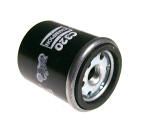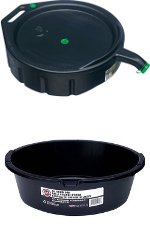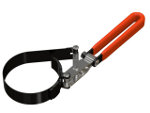How to Change Your Oil
Author: steve Published Under: Automobiles

Changing the oil in your car or truck is one of the easiest types of regular car maintenance.
Often, you might not save that much by changing your own oil when compared to a place like Jiffy Lube, but over the course of a few years, the savings do add up. However, you are sure that it is done right and usually it also means using better parts than most quick lube places. All too often, those working at Jiffy Lube are not mechanics and instead high school children, so it is common for simple mistakes, such as forgetting to replace the oil cap, to occur. However, these types of simple mistakes can translate into major damage to your vehicle.
Getting the Oil Filter, Oil, and other Tools
The first step to changing your oil is to get an oil filter and oil from your local auto parts store. However, before you go in, check your air filter to see if it needs to be replaced. Air filters should be relatively clean and can be visibly inspected, typically by only popping the hoods and removing a few clasps on the air filter housing.
If you haven't replaced your spark plugs in a while, doing it with your oil change is also a good idea.
When you go to the auto parts store, make sure to ask if there are any oil change specials, because there is almost always a special deal for purchasing oil and an oil filter at the same time. If you are unsure about what type of oil to get 10W-30 is almost always the right weight, but depending on the climate and age of the car, this might not be the case, so don't be afraid to ask the clerk for some advice.
Also, you will likely need an oil wrench to remove the oil filter, with most oil wrenches having a long handle and a metal band on them. Depending on the location of the oil filter, a pipe wrench can also often be used. If you are buying a oil wrench, make sure that it fits both the old oil filter and the new one, as there can be some difference in size between different brands of oil filters.
 You will also need an oil pan, which is used to collect the oil. There are a few different types, with some being nothing more than a plastic pan, while others are basically containers and have a place to set your oil filter and let it drain. If you purchase one with a container, make sure you know how it works and play with it some before draining the oil. This is because if you do not open it up correctly, including opening the air hole to allow it to quickly fill up, it is possible to make a very big mess.
You will also need an oil pan, which is used to collect the oil. There are a few different types, with some being nothing more than a plastic pan, while others are basically containers and have a place to set your oil filter and let it drain. If you purchase one with a container, make sure you know how it works and play with it some before draining the oil. This is because if you do not open it up correctly, including opening the air hole to allow it to quickly fill up, it is possible to make a very big mess.
Ramps will also make it much easier, although jack stands can also be used. If you own a truck, you may not even need to use ramps, but since elevating the front of the car helps to drain the oil, using ramps is a good idea.
Preparing to Change the Oil
 Before you get started, take some time to familiarize yourself with the location of the oil filter and oil pan. The oil pan is located on the bottom of the engine and should have a bolt in it. Removing this bolt, often called the oil plug, will cause the oil to run out of the engine.
Before you get started, take some time to familiarize yourself with the location of the oil filter and oil pan. The oil pan is located on the bottom of the engine and should have a bolt in it. Removing this bolt, often called the oil plug, will cause the oil to run out of the engine.
Some motors have an inverted oil plug, which uses a star shaped bit to remove, so if you haven't changed your oil before, it is a good idea to stick your head under the car and check the location of the oil plug before going to the auto store.
It is also important to make sure that you are looking at the engine and not the transmission, as both the engine and transmission usually have a drain plug, so you don't want to accidentally drain the transmission fluid.
Keep in mind that oil gets very hot very quickly, so if you have been driving a lot, you would want to wait a little while before changing the oil. However, with that said, if the oil is a little hot, it will flow better, so you don't want to let it cool completely.
Once you have driven the car up onto the ramps, go ahead and remove the oil cap on the top of the engine. This will allow the oil to flow more quickly out of the engine, as air is sucked into the top.
Then, with the plastic oil container in place under the oil pan, remove the oil plug from the bottom of the engines oil pan. Do so carefully and make sure you are going in the right direction(Lefty Loosy,) because you do not want to strip the oil plug. Oil will begin to flow out of the plug before it is completely removed, so you may want to use a fixed wrench instead of a ratchet, at least once you get it mostly loose.
Once the oil plug is removed, make sure to set it somewhere safe, as you don't want to have to stick your hand in the used oil to find it. After the oil has mostly drained out of the engine and slowed to a trickle, you can remove the oil filter.
Using the oil filter wrench, and again making sure that you are going in the right direction, slowly remove the oil filter. Keep in mind that there will still be some oil likely in the filter, which is why you remove the oil plug and drain the oil first. So, once it is removed, keep it upright and clean any spilled oil off of the engine and floor.
After the engine has completely drained, place the oil plug back in place and remove the plastic oil container. If the oil container has a screw top, go ahead and secure it in place before moving it. Once the oil plug is in place, put the clean oil filter back on. First, however, wipe a small bit of oil over the rubber seal on the filter using your finger.
When putting the oil filter back in place, make sure not to over tighten it and use your hand, instead of the oil filter wrench. If you don't feel like you can get it tight enough with your hand, you can use the wrench at the end to snug it up, but again, you want to be very careful that you don't over tighten.
After the oil filter is in place and the oil plug secured, you can begin adding oil. Go ahead and pull the dipstick up a little bit, so that you get a more accurate reading and don't replace it until you are ready to check your oil levels. The person at the auto parts store should be able to tell you how much oil your vehicle requires, as well as it being in your cars manual. Start by adding about 2/3 to 3/4of what is recommended and then check the oil level with the dipstick.
Back the car off of the ramps, properly dispose of the oil, either at your landfill or at your local auto-store, and you are good to go. You are now safe with the knowledge that the job was done right and good parts were used, with the added bonus of saving a few dollars.